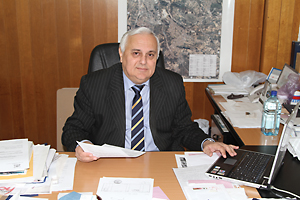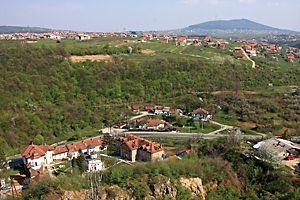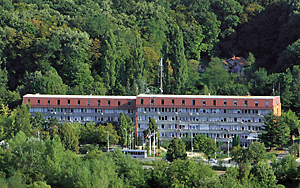Visit
BELGRADE MUNICIPALITY OF RAKOVICA, FROM THE CRISIS OF INDUSTRY TO THE CENTER OF DEVELOPMENT
Anticipating a New Era
Both the Kingdom and Republic were proud of it. This is where our first airplane engine was manufactured, the first truck, the first cooling apparatus, first tractor… At its zenith, in the 1980s, its industry employed more than 25.000 people. Then followed the disintegration of the state, market, industry, as well as the dark whirlpools of transition. The bypass motorway around Belgrade on Corridor 10 is currently in construction and this vital traffic route will cross with the Ibarska Highway in this municipality, thereby bringing Rakovica into the very center of attention of the most powerful local and foreign investors. Entirely new perspectives will open before it. How will Rakovica welcome them?
By: Jovo Bajić
Photo: Dragan Bosnić
 The Belgrade municipality of Rakovica is famous for two of its symbols: the medieval monastery with the same name dedicated to Archangel Michael, and the metal industry complex erected in the XX century. After the recently passed away Patriarch of Serbia Pavle had been buried in the Rakovica Monastery churchyard according to his testament, this shrine became even more famous and interesting (by the number of pilgrims visiting it, it will probably reach Ostrog, the most visited place of the Serbian Orthodox Church). As for the big metal industry complex in Rakovica, even the Kingdom of Yugoslavia and Belgrade as its capital were proud of it. This continued in the Yugoslav republic created after World War II. The first airplane engines were manufactured in Rakovica, the first Yugoslav motor vehicle, the first local tractor. However, at the beginning of the XXI century, in the dark whirlpools of transition, this symbol of Rakovica seems to be extinguishing unstoppably. Its metal industry complex did not keep up, it was not adjusted to the The Belgrade municipality of Rakovica is famous for two of its symbols: the medieval monastery with the same name dedicated to Archangel Michael, and the metal industry complex erected in the XX century. After the recently passed away Patriarch of Serbia Pavle had been buried in the Rakovica Monastery churchyard according to his testament, this shrine became even more famous and interesting (by the number of pilgrims visiting it, it will probably reach Ostrog, the most visited place of the Serbian Orthodox Church). As for the big metal industry complex in Rakovica, even the Kingdom of Yugoslavia and Belgrade as its capital were proud of it. This continued in the Yugoslav republic created after World War II. The first airplane engines were manufactured in Rakovica, the first Yugoslav motor vehicle, the first local tractor. However, at the beginning of the XXI century, in the dark whirlpools of transition, this symbol of Rakovica seems to be extinguishing unstoppably. Its metal industry complex did not keep up, it was not adjusted to the  new era and different conditions of doing business, so thousands of workers in Rakovica were left without jobs. new era and different conditions of doing business, so thousands of workers in Rakovica were left without jobs.
In the meantime, tells Dušan Djaković, deputy president of the municipality of Rakovica for National Review, new perspectives of economical development are clearlyoutlined. These perspectives are opened by the vital European traffic route Corridor 10, respectively the bypass motorway around Belgrade on this Corridor, which passes through Rakovica and intersects with another traffic artery, Ibarska Highway. Due to these two particularly important traffic routes, the peripheral city municipality of Rakovica suddenly regained significance. Something similar happened for the first time nine decades ago, when the railway passed through Rakovica and became the crucial reason for erecting the metal industry complex there, which brought an up to then unthinkably rapid development. Nowadays, numerous companies and businesspeople from the country and abroad are looking for locations for their new plants in Rakovica, near the vitally important traffic routes.
PLANNING, TECHNOLOGY, INITIATIVE
 – A kind of an introduction to the opening of new perspectives and arrival of the long awaited better times is also the sudden growing interest of big commercial systems for opening hypermarkets and wholesales on the territory of our municipality – says Dušan Djaković. – There are many rational reasons for opening such commercial objects. Besides the 130.000 inhabitants of the Rakovica municipality, there are also people from the neighboring municipalities of Čukarica, Voždovac, Obrenovac and Barajevo, who will certainly be oriented towards these objects. Not to mention the number of people from Rakovica who would be employed there, as well as many other advantages. We will speak in more detail about them when the time comes. – A kind of an introduction to the opening of new perspectives and arrival of the long awaited better times is also the sudden growing interest of big commercial systems for opening hypermarkets and wholesales on the territory of our municipality – says Dušan Djaković. – There are many rational reasons for opening such commercial objects. Besides the 130.000 inhabitants of the Rakovica municipality, there are also people from the neighboring municipalities of Čukarica, Voždovac, Obrenovac and Barajevo, who will certainly be oriented towards these objects. Not to mention the number of people from Rakovica who would be employed there, as well as many other advantages. We will speak in more detail about them when the time comes.
Watching ahead and anticipating future events, the munici pality administration in Rakovica is already attempting to strategically adjust its work and activities to what is about to come. The construction of new industrial plants is expected to initiate construction of residential and other objects. Construction land is already awaiting the architects, the municipality departments are trained for professional and efficient processing of requests, respectively fast issuance of construction permits. The municipality administration was modernized, the space rearranged, new technologies introduced, and the municipality clerks organized in such a way that both the investors and common people can get what they need without unnecessary waiting. pality administration in Rakovica is already attempting to strategically adjust its work and activities to what is about to come. The construction of new industrial plants is expected to initiate construction of residential and other objects. Construction land is already awaiting the architects, the municipality departments are trained for professional and efficient processing of requests, respectively fast issuance of construction permits. The municipality administration was modernized, the space rearranged, new technologies introduced, and the municipality clerks organized in such a way that both the investors and common people can get what they need without unnecessary waiting.
The new Rakovica Information Center is unique in Serbia. Due to the introduced high quality digital technology, the territory of the  whole Municipality is covered with video surveillance. Thus the entire life in the Municipality, each school and kindergarten, intersections and traffic, institutions and commercial objects, can all be monitored from one electronic center. It has proven to be very efficient in a series of natural and social situations, as well as in the joint efforts for suppressing criminal behavior. We saw all this on a large video beam in the Municipality Information Center. whole Municipality is covered with video surveillance. Thus the entire life in the Municipality, each school and kindergarten, intersections and traffic, institutions and commercial objects, can all be monitored from one electronic center. It has proven to be very efficient in a series of natural and social situations, as well as in the joint efforts for suppressing criminal behavior. We saw all this on a large video beam in the Municipality Information Center.
A hundred years ago however, this urban area used to look completely different. It was an idyllic Šumadija landscape. Old settlements used to be on the river terraces of the Topčider River which flows into the Sava, on the slopes of the Pinosava-Resnik basin, Orlovica, Straževica, Petlovo and Miljakovačko Brdo. Some of them, such as Resnik, Kijevo, Kneževac, were mentioned already in 1528, in a Turkish defter (census of tax withholding agents).
GLORIOUS HISTORY OF INDUSTRY
 Certainly the most persistent witness of this area’s history is the Rakovica Monastery, where, as we have said, Patriarch Pavle (Stojčević, 1914-2009) has recently been buried. The last Serbian patriarch of the XX century himself chose his eternal resting place, besides the place where Patriarch Dimitrije (Pavlović, 1846-1930) is resting, the first Serbian patriarch in that century and first head of the renewed Patriarchate of the Serbian Orthodox Church. Nearby is the tomb of Karadjordje’s duke from the First Serbian Uprising Vasa Čarapić, ”Prince of Avala”, who died heroically on November 30, 1806 in the attack on Stambol Gate during the liberation of Belgrade from the Turks. (A street in the center of Belgrade was named after him, leading from the Republic Square, the place where Stambol Gate used to be, to Kalemegdan; the monument of Vasa Čarapić stands in the park by the National Theater.) Tombs of some members of the royal family of Obrenović are also in the Rakovica Monastery churchyard. Certainly the most persistent witness of this area’s history is the Rakovica Monastery, where, as we have said, Patriarch Pavle (Stojčević, 1914-2009) has recently been buried. The last Serbian patriarch of the XX century himself chose his eternal resting place, besides the place where Patriarch Dimitrije (Pavlović, 1846-1930) is resting, the first Serbian patriarch in that century and first head of the renewed Patriarchate of the Serbian Orthodox Church. Nearby is the tomb of Karadjordje’s duke from the First Serbian Uprising Vasa Čarapić, ”Prince of Avala”, who died heroically on November 30, 1806 in the attack on Stambol Gate during the liberation of Belgrade from the Turks. (A street in the center of Belgrade was named after him, leading from the Republic Square, the place where Stambol Gate used to be, to Kalemegdan; the monument of Vasa Čarapić stands in the park by the National Theater.) Tombs of some members of the royal family of Obrenović are also in the Rakovica Monastery churchyard.
 Rakovica experienced its first real development after World War I, when this area, through which the Belgrade-Niš railway used to pass, was established as an industrial zone. The engine industry named after Rakovica (IMR) was built right here in 1927 and began manufacturing airplane engines. Then, in 1928, the ”Jugostroj” factory was erected, which produced cooling apparatuses under license of the Czech company MRAZ. The rubber products manufacturer ”Rekord” began working before World War II, and the first trucks were produced in 1939 under license of the Czech manufacturer ”Praga”. Rakovica experienced its first real development after World War I, when this area, through which the Belgrade-Niš railway used to pass, was established as an industrial zone. The engine industry named after Rakovica (IMR) was built right here in 1927 and began manufacturing airplane engines. Then, in 1928, the ”Jugostroj” factory was erected, which produced cooling apparatuses under license of the Czech company MRAZ. The rubber products manufacturer ”Rekord” began working before World War II, and the first trucks were produced in 1939 under license of the Czech manufacturer ”Praga”.
After World War II, the engine manufacturing plant ”21. maj” was founded in Rakovica, and produced the first tractor in the country. In the 1980s, the Rakovica industry employed more than 25.000 people. (...)
However, as we have said, the industrial complex in Rakovica, like others in Serbia, could not handle the impacts at the end of the previous and beginning of this century. Thus nowadays, all this in Rakovica looks completely different.
BETWEEN TWO NEW BEGINNINGS
 The first Municipality administrative center in this area was Kneževac in the late XIX century. The village of Rakovica was also within the Kneževac Municipality. In 1929, in the new administrative division, all these settlements were included in the Belgrade city administration. After World War II, in 1952, Rakovica again became a city municipality, and in 1960 it was merged with the municipality of Čukarica. The first Municipality administrative center in this area was Kneževac in the late XIX century. The village of Rakovica was also within the Kneževac Municipality. In 1929, in the new administrative division, all these settlements were included in the Belgrade city administration. After World War II, in 1952, Rakovica again became a city municipality, and in 1960 it was merged with the municipality of Čukarica.
– A new beginning in the history of the Rakovica Municipality was in 1974. The then Belgrade City Assembly decided to divide the Municipality of Čukarica into two parts. The settlements of Košutnjak, Kanarevo brdo, Miljakovac, Miljakovački Izvori, Stara Rakovica, Skojevsko Naselje, Vidikovac, Kneževac, Resnik, and Avala-grad became parts of the newly founded Municipality of Rakovica – reminds Dušan Djaković. – It is an area of 3.044 hectares. Before the division, the Municipality of Čukarica had a population of about 230.000 people. After the division Rakovica had 76.000 inhabitants, whereas today its population is about 130.000.
 In 1842, a school was opened in Resnik. It was the oldest school in Rakovica, established eight years before the one in Kneževac. In the XX century, a school in the Railway Colony was opened in 1933, and two years later, in 1935, in the settlement of Rakovica. Both were four-grade schools. In 1842, a school was opened in Resnik. It was the oldest school in Rakovica, established eight years before the one in Kneževac. In the XX century, a school in the Railway Colony was opened in 1933, and two years later, in 1935, in the settlement of Rakovica. Both were four-grade schools.
– Nowadays, there are eight elementary schools in the territory of the Municipality of Rakovica with 8.300 students. We have four high schools: gymnasium, schools of economics, mechanical engineering, and crafts school ”Petar Leković” (for educating children with development delay). In the early 1970s, the renowned Faculty of Organization Sciences (later moved to Voždovac) was founded in the territory of our Municipality, in the former boarding school for students who attended metal processing schools.
”Pionirski grad” (”Pioneers’ City”) is also in the Municipality of Rakovica. For decades after World War II, it has been the gathering place of Belgrade elementary school students. Creative gatherings, classes and out of class activities, sports competitions and cultural events – all this took place in ”Pionirski grad”. During the wars in the ruins of Yugoslavia, the bungalows where Belgrade elementary school students used to stay were turned into temporary homes for numerous refugees. Many of these obj ects today are ruined and not used for their original purpose. The Municipality of Rakovica intends to renovate and reopen ”Pionirski grad”. ects today are ruined and not used for their original purpose. The Municipality of Rakovica intends to renovate and reopen ”Pionirski grad”.
An important place in Rakovica is also the sports center under the Košutnjak forest, owned by the Municipality. It has a sports hall, a complex of open sports courts for football and other sports, as well as many accompanying events. Many people from Rakovica, of all ages, regularly come here to socialize and play sports.
The Cultural Center of Rakovica, across the street from the Municipality building, was opened in 1976. It is also experiencing a kind of a new beginning. The universal concert hall with 352 places, supplied with sound and light equipment, was renovated. The Center hosts theatrical plays, theatrical festival, concerts, it has an art gallery… Also under the roof of this modern cultural center are the Music School ”Davorin Jenko”, Cultural-Artistic Society ”Dimitrije Koturović”, Ballet Studio FLEX, Acting Studio ”Maska”, Singing Society ”Prelo”...
***
Witness of History
Although built earlier, the Monastery of Holy Archangel Michael was first mentioned in historical chronicles in the second half of the XVI century. It has been destroyed and renewed several times; some say it was also moved. In the new Serbian history, several important meetings were organized here and agreements of wide significance reached. After World War I it housed a monastic school. One of the Monastery objects, erected in 1925, used to be the home for Serbian refugee children during World War II. This orphanage, founded by the war government of Milan Nedić, provided shelter for Serbian children whose parents had been slaughtered in Croatia. After World War II, it became a seminary.
***
School
The recently renovated elementary school ”14. oktobar” in Kneževac is one of the important cultural monuments of Rakovica. It was built 160 years ago. Dušan Djaković, deputy president of the Municipality, was one of its numerous students. He remembers well how classes were held after World War II. There was a giant chestnut tree in front of the school and there was a big bell on it. The famous aunt Marija, serving lady, would ring the bell half an hour before the beginning of the first class. The bell could be heard all over the village, and it was a sign for the students to start off to school. The second ring of the bell meant the beginning of the class.
***
Straževica
Since the North Atlantic Treaty Organization’s aggression on Serbia in the spring of 1999, the Straževica hill above the Rakovica Monastery has also become a historical monument. There is hardly a place in Serbia which was hit more than this one. Each day it was targeted with loads of bombs and long distance projectiles. During the 78 days of the aggression, Straževica was continuously hit for 70 days. Yet, it did not fall, its activities did not stop, and the reason it was hit so hard remained intact within it. Some Serbian soldiers lay their lives for it to stay that way. An unusual monument was erected on the top of Straževica so the nation would eternally remember them.
|
